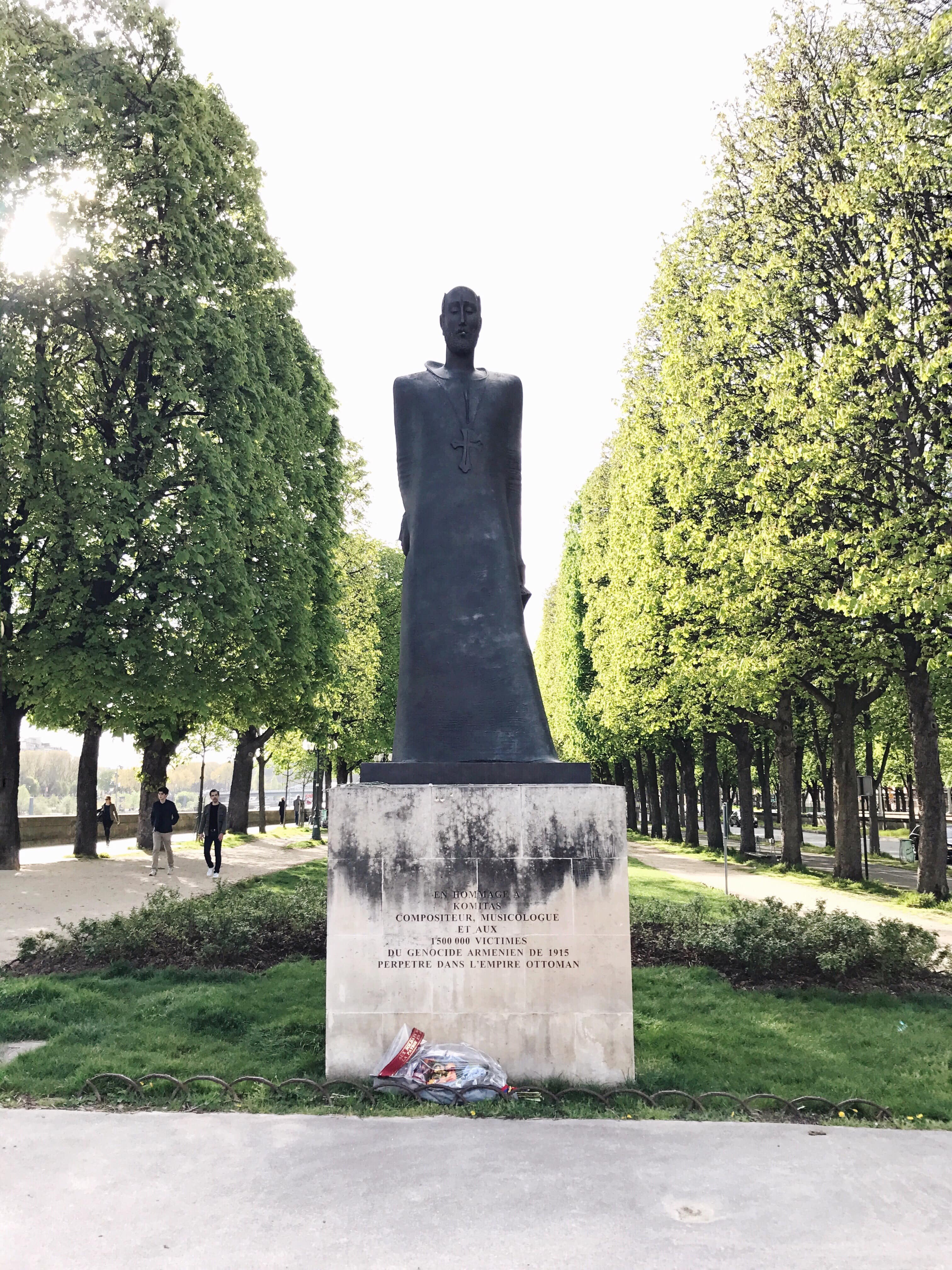As we are about to commemorate the victims of the Armenian Genocide of 1915 in the Ottoman Empire, Armenians all over the world will be organizing silent marches & protests in order to get recognition for the atrocities committed by the Young Turks government during the last days of the Empire.
The Komitas Monument
In 1983 the Armenian community in Paris requested permission to erect a memorial monument in honor of the victims of the Armenian Genocide and the late great Armenian composer Komitas Vardapet. The monument sits on a pedestal of 2 meters high & the bronze statue of Komitas is 4 meters tall. Construction began in January 2002 and was completed on April 22, 2003 ready for it’s opening on Aril 24, 2003.
Design: David Babayan – Yerevantsi
Location: In the middle of a square in the heart of Paris. Located near the Armenian Apostolic Church.
Address: Cours Albert 1, Paris, France
Photographer: avecmar
Inscription:
Until the genocide of 1915, the Reverend Father Komitas collected the songs of oral tradition of the Armenian people and had them retranscrit. He thus was able to save a partimony of universal range (translated from French).
In the memory of the voluntary engaged Armenian fighters and resistants who died for France (translated from French).
In homage to Komitas; composer, musicologist and to the 1.5 million victims of the Armenian Genocide, committed in the Ottoman Empire in 1915 (translated from French and Armenian).
Komitas & The Armenian Genocide
Komitas, also known as Soghomon Soghomonyan, was born on September 26, 1869 in Anatolia, Turkey, in the town of Koutina (Ketaia). From his early years Komitas showed to have a gift for singing, however, his childhood was a troubled one.
Before the age of 11, Komitas lost both his parents and became an orphan. But soon a life changing event would give Komitas a new purpose in life. In 1881 the priest of Koutina, G. Dertsakyan, had to leave for Echmiadzin to be ordained a bishop. At the request of the Catholicos he brought the gifted orphan boy with him to study at the Echmiadzin Church Seminary. Twelve-year-old Soghomon was selected out of the other 20 orphans to study at the Seminary. As it was forbidden to speak Armenian at that time the boy spoke Turkish and when being greeted by the Catholicos Gevorg IV, he replied, “I don’t speak Armenian if you wish I will sing”.
“I don’t speak Armenian if you wish I will sing”.
Then with his fine soprano voice, he sang an Armenian sharakan (a church hymn) without understanding the words. Due to his exclusive aptitude, Soghomon overcame all the obstacles in a very short time and perfectly learned Armenian.
In 1890 Soghomon was ordained a monk and in 1893 he finished studying at the seminary. He was ordained a “Vardapet” (priest) and acquired his new name “Komitas” – the name of the outstanding poet of VII century, the author of sharakans.
At the seminary, Komitas was assigned to teach music. Along with teaching, Komitas organized a choir, an orchestra of folk instruments, and treated folk songs; he made the first researchers in the field of Armenian Church music.
In 1895 Komitas was ordained an archimandrite and later on went to Berlin, the large music center in Europe to study under the protection of the Catholicos, being financed by the largest Armenian oil magnate Alexander Mantashyan. Upon the invitation of the International Music Association, he held lectures devoted to the Armenian church and contemporary music in comparison with Turkish, Arabic and Kurdish music.
In September 1899 Komitas returned to Echmiadzin and started his musical activity right away. In a short period, he radically changed the system of teaching music in the seminary, organized a small orchestra and perfected the performance level of the choir. He visited various regions of Armenia treating and putting down thousands of Armenian, Kurdish, Persian and Turkish songs.
In 1910 Komitas left Etchmiadzin and went to Constantinople. Komitas wanted to establish a National Conservatory with which he connected the further destiny of his people’s music. But the composer failed to accomplish this plan. However, he managed to organize a popular mixed choir of 300 men and called it “Gousan”. For the majority part, Armenian folk songs constituted the concerto program.
Komitas would often spend his time touring, giving presentations and lectures; he also acted as a soloist and conductor.
In 1906 after one of the concertos the prominent French composer Claude Debussi exclaimed excitedly:
“Brilliant father Komitas! I bow before your musical genius!”
In the period of World War I the government of Young Turks initiated their program on the extermination of the Armenian people. In April 1915, Komitas was arrested together with other Armenian leaders writers, publicists, physicians, and lawyers. After the arrest, accompanied by violence, he was deported far in Anatolia where he became a witness of the brutal extermination of the Armenians. And in spite of the fact that due to the intervention of influential figures Komitas was returned to Constantinople, the nightmare he had experienced left a deep ineradicable impression.In 1916 Komitas’ mental health deteriorated and he was put in a psychiatric hospital. However, there was no hope that he would recover. The medicine was powerless against the destructive disease.
In 1916 Komitas’ mental health deteriorated and he was put in a psychiatric hospital. The genius of Armenian music found his final shelter in Paris, in the suburban sanatorium Vil-Jouif where he spent almost 20 years of his life.On the 22nd of
On the 22nd of October, the life of Komitas came to an end. In the spring of 1936, his remains were transported to Armenia and buried in Yerevan – in the Pantheon of prominent art figures.
No less tragic was the destiny of Komitas’ creative legacy. The majority of his manuscripts were destroyed or lost all over the world.
Sources:

